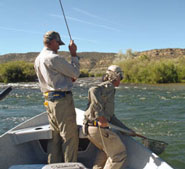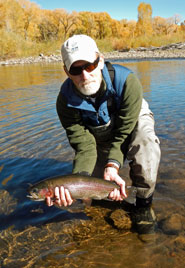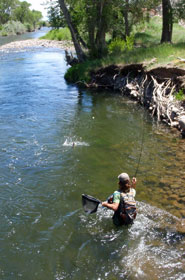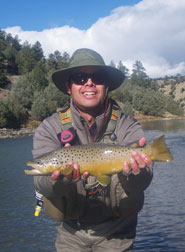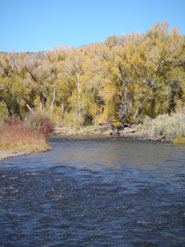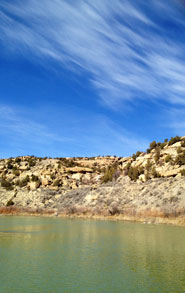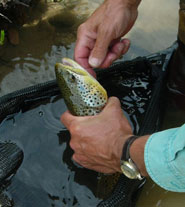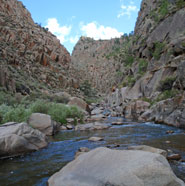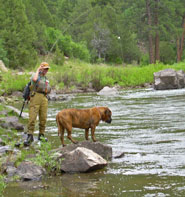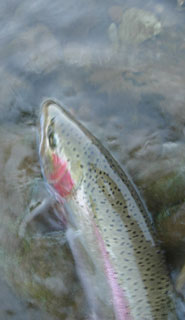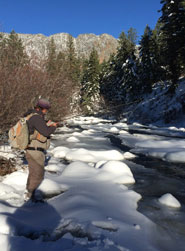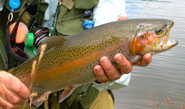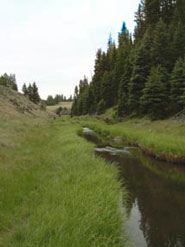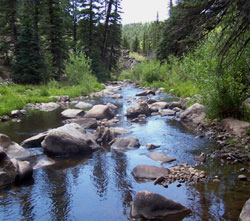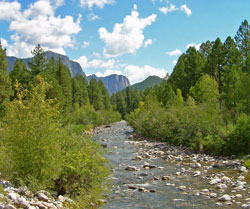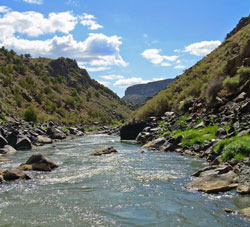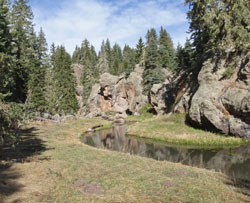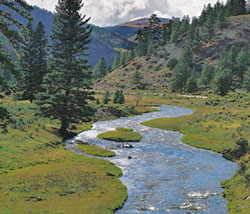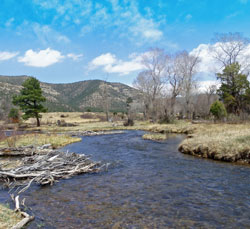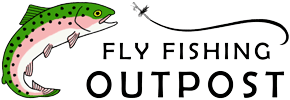New Mexico's Best Fly Fishing Rivers & Streams
Northern New Mexico's rivers and streams offer the fly fisherman great year-round trout fishing, on many types of water.
We can take you fly fishing on high mountain meadow creeks, steep gradient freestone streams, small headwaters, larger rivers and/or tailwaters below dams. Please look over the spots described below to see if there is one spot or area you are especially interested in. If you have a certain type of river or stream you would like to experience, let us know. Northern New Mexico's fishing waters have four main species of trout available to be caught (see our
New Mexico Trout page). If you are interested in fishing for a particular specie of trout, we can take you to a spot where you will have the best chance of catching the type of fish you are looking for.
The Chama River & Major Tributaries
Chama River:
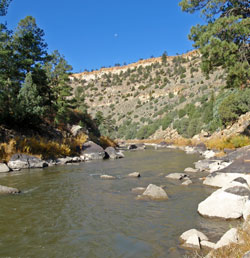
The Chama is probably one of the West's most undiscovered and diverse trout rivers. Starting in the mountains on the Colorado border, it flows as a freestone stream for many miles through high mountain forests and meadows. Below El Vado reservoir, it runs for over thirty miles through rugged, multi-colored sandstone canyons and rough terrain with limited access. For six miles of this section it passes through the 50,000 acre Chama River Canyon Wilderness area. Another less remote stretch flows from below Abiquiu dam down to the Rio Grande. All of the parts of the Chama have good populations of large wild browns and rainbows (the state record brown trout was caught in the river below El Vado). The other nice thing about the Chama is that, by its being so diverse, there is almost always a section of it that is fishing well. Because most of the river is quite remote, you usually see lots of wildlife, the scenery is unrivaled and the fishing can be outstanding. The Chama River is truly a "wild river", offering an unforgettable fishing experience. Please check out our video
"Fly Fishing the Chama River in Northern New Mexico".
Vallecitos River:
Located northwest of Santa Fe in the Carson National Forest, the Vallecitos is a small stream that sees very little fishing pressure. It contains several canyons and stretches running through high forest land that are easy to access. In the stream's lower canyon reaches it has good populations of wild browns and a few rainbows. Further upstream there is a natural barrier that prevents the brown trout from moving higher up. In this upper part of the stream, which is seldom fished, there is a large population of wild rainbow and brook trout. When fishing the Vallecitos, one can expect to catch lots of small to medium size fish in some of our most beautiful high desert and mountain country.
Brazos River:
For the most part, the Brazos River flows through private land. However, there are approximately 4 to 5 miles of the river that is open to public fishing. This reach provides good fishing for wild browns and stocked rainbows. There are incredible views of the Brazos cliffs. Because this part of the Brazos is near its confluence with the Chama, we are often able to fish both rivers in a day. There is often great terrestrial/dry fly fishing in the summer to early fall with a "hopper-dropper" rig being the way to go. The upper part of the Brazos River offers some of the best high alpine meadow fishing in the West. We have access to two stretches of private water on this part of the river. Please contact us for more information.
The Rio Grande & Major Tributaries
Rio Grande:
The Rio Grande has fishable trout water from just north of Espanola upstream to the Colorado border. While this may seem like a lot of river to fish, much of it flows through the Rio Grande Gorge, which is extremely difficult to access. In general, the Rio Grande is a river of fewer but larger wild fish. We start to fish "the Rio" in the early spring before it becomes high and turbid from the spring runoff, which can often last until mid to late summer. In the early fall, when the water clears and big browns are getting ready to spawn, is the best time to fish here, with a chance of landing some really nice trout. The Rio Grande has a tremendous caddis hatch that usually starts about Mother's Day and lasts for several weeks. If you want to fish big pocket water in one of the most beautiful canyons in New Mexico, the Rio Grande Gorge is your spot.
Red River:
The Red River flows into the Rio Grande from the east, north of the town of Questa. New Mexico Game and Fish operates a trout hatchery on the lower part of the stream. Some of the best fishing on the Red is found downstream of this hatchery where warmer water from springs enter the river and enhances fish growth. In mid to late winter there is a spawning run of cuttbows (rainbow/cutthroat hybrids) that move into the lower Red River to spawn. They are strong fighters, averaging 15 to 25 inches in length. The hike down to the confluence of the Red and the Rio Grande is on a winding trail down from the canyon rim. It is quite a hike back out but the incredible natural beauty of the area makes it all worthwhile.
Rio Pueblo de Taos:
This tributary to the Rio Grande flows through a gorgeous canyon and contains some of the best small pocket water fishing in the area. It has a great population of wild browns and fishes best in spring before high runoff and then again in the fall. Because of the steepness of the canyon walls that border the stream and the extremely steep gradient, it is not a place for the faint of heart. This does mean that you will be fishing a stream that sees very few other fishermen and though easily accessible, it is still very wild. If you are willing to make the hike into the upper sections of the canyon, the odds of a success are very good - you better eat your Wheaties though!
Rio de Los Pinos
The Los Pinos starts high in the San Juan mountains of Colorado and works its way to the east towards the Rio Grande. There are over 20 miles of the river in New Mexico offering beautiful, freestone trout water with great fishing for both brown and rainbow trout. The lower section of this stretch is wider and more open and as you work upstream the river narrows as the canyon become more pronounced and the altitude increases. With great riffles, pools and pocket water, all of the Los Pinos is easy to wade and fish. Early in the season nymph fishing will produce the most hook-ups but the summer progresses, the dry fly fishing really takes off. In the late summer and into the fall, the brown trout become more aggressive giving fishermen some great action with the chance of landing a real beauty. The Rio de Los Pinos is a very fun river to fish and a beautiful place to spend a day.
The San Juan River
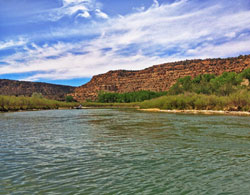
The San Juan River is a fishery that everyone should experience. It is world renowned as one of the greatest tailwater trout fisheries there is. In the top 4 miles of river below the dam, there are over 20,000 fish per mile, averaging 17 inches in length; you couldn't ask for more. Most of the fish are rainbows but the population of browns seems to be increasing. It is primarily a small fly fishery with size #20 to #26 midges on light tippet being the standard setup. It is quite a thrill to hook and land a large fish on this type of gear. The river is big by New Mexico standards but very easy to wade and, with the density of fish being so great, long casts are not usually necessary. We do both float trips (fishing from a drift boat) and wade trips on the San Juan. Fishing from the boat enables you to fish many spots you are unable to wade to. Fishing on the San Juan is excellent at any time of year. There are often many other fishermen on the river but because it is so large, you can always find a good spot of your own. The one drawback to fishing the San Juan is that it is not close to anywhere so it makes for a very long day trip. If you can do it, we would encourage booking at least an overnight trip.
The Pecos River & Tributaries
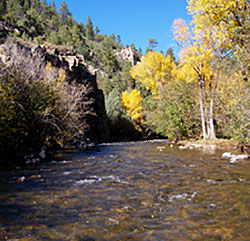
The Pecos River is a beautiful, small to medium sized, stream that flows through many different types of terrain. Because it has a road that follows most of its course, it gets a lot of fishing pressure during the summer months. Even so, one can go to areas that are not too crowded. The Pecos River has a good population of wild brown trout and is heavily stocked with rainbows. A major tributary of the Pecos is the Rio Mora. Where the two streams converge, each carries about the same flow and is about the same size. Like the Pecos, the Mora has a good population of browns and is stocked with rainbows in the last half-mile upstream of the confluence with the Pecos. For the angler who wants solitude and the chance to fish for Rio Grande cutthroats, the various small tributaries that form the Mora offer this opportunity. Another major tributary of the Pecos is Cow Creek. Unlike the Mora, Cow Creek has very limited public access (check out The Bar X Bar Ranch on the
Private Ranches page for a great private stretch of Cow Creek). All of these streams fish well before spring runoff. After the runoff, the fishing picks up again and is good throughout the summer and into fall.
The Valles Caldera National Preserve
One of the most unique trout fisheries is the Valles Caldera National Preserve (VCNP). This is the ultimate in mountain meadow fly fishing. Picture this, as you stalk along the banks of the stream, you are constantly seeing trout moving away from you. In some places you drop your fly over the grass and hope it's in the water. When you hear the gulp of a fish you set the hook. The average number of pounds of trout per surface acre of water in the western United States is about 49 pounds. The streams on the VCNP contain approximately 350 to 400 pounds of trout per surface acre. Because of this amazing trout population the trout are not large but they are wild and full of fight and the scenery is beyond belief. VCNP also has a very large elk herd that often comes down to the streams in the early evenings. This is quite a sight to behold after a day of fishing. Note: There is an additional per fisherman access fee to the fish on the VCNP. Please see the
Fishing Trips & Rates page.
The Jemez River & Tributaries
The Jemez River and several of its tributaries including the East Fork of the Jemez, San Antonio Creek, the Rio Guadalupe, and the Rio Cebolla offer fly fishermen the opportunity to fish a wide variety of different streams. You can fish mountain meadow streams for browns and Rio Grande cutthroats or rocky freestone streams for browns and rainbows. All of these streams are small and they do not grow large trout, but produce lots of them! The fishing usually starts in March, before spring runoff. After the peak of the runoff in late May, most of the streams will have a stonefly and willow cicada hatch lasting through June. The fishing is good throughout the rest of the summer and into the fall.
Costilla Creek
Costilla Creek is possibly New Mexico's best wild Rio Grande cutthroat stream. It is actually a small tailwater flowing out of Costilla reservoir, down through the gorgeous mountain meadows and gorges of the Valle Vidal. Most of the upper Costilla is fly fishing only. The wading is very easy and casting is unobstructed in the wide open meadows. It is a great stream for relaxing fishing with dry flies and small nymphs. When the conditions are good, you can expect to have pretty much non-stop action all day long. Day trips to Costilla Creek are possible but it is up by the Colorado border so we would encourage you to consider an overnight trip. We can arrange all inclusive packages to Costilla Creek that cover all food, lodging, guiding and travel.
The Cimarron River
The Cimarron is one of the prettiest smaller rivers in the state. It is a tailwater which flows out of the dam on Eagle Nest Lake. This river offers many types of waters to fish on, ranging from canyon stretches to open meadows; riffles and deep pools along with channels and undercut banks. For such a small river, there is an amazingly diverse amount of insect life which supports a very healthy population of wild brown trout, mostly in the 10 to 15 inch size range. The varied types and large numbers of bugs in the Cimarron make for incredible dry fly fishing. On a typical day, one can often catch fish on the surface on any number of different fly patterns. The terrestrial fishing in the summer and early fall can be epic. If there aren't any fish coming to the surface, the nymph fishing is always excellent. The Cimarron is a good river to consider when fishing out of Taos.

